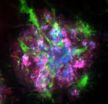(Press-News.org) You're waiting at a bus stop, expecting the bus to arrive any time. You watch the road. Nothing yet. A little later you start to pace. More time passes. "Maybe there is some problem", you think. Finally, you give up and raise your arm and hail a taxi. Just as you pull away, you glimpse the bus gliding up. Did you have a choice to wait a bit longer? Or was giving up too soon the inevitable and predictable result of a chain of neural events?
In research published on 09/28/2014 in the journal Nature Neuroscience, scientists show that neural recordings can be used to forecast when spontaneous decisions will take place. "Experiments like this have been used to argue that free will is an illusion," says Zachary Mainen, a neuroscientist at the Champalimaud Centre for the Unknown, in Lisbon, Portugal, who led the study, "but we think that interpretation is mistaken."
The scientists used recordings of neurons in an area of the brain involved in planning movements to try to predict when a rat would give up waiting for a delayed tone. "We know they were not just responding to a stimulus, but spontaneously deciding when to give up, because the timing of their choice varied unpredictably from trial to trial" said Mainen. The researchers discovered that neurons in the premotor cortex could predict the animals' actions more than one second in advance. According to Mainen, "This is remarkable because in similar experiments, humans report deciding when to move only around two tenths of a second before the movement."
However, the scientists claim that this kind of predictive activity does not mean that the brain has decided. "Our data can be explained very well by a theory of decision-making known as an 'integration-to-bound' model" says Mainen. According to this theory, individual brain cells cast votes for or against a particular action, such as raising an arm. Circuits within the brain keep a tally of the votes in favor of each action and when a threshold is reached it is triggered. Critically, like individual voters in an election, individual neurons influence a decision but do not determine the outcome. Mainen explained: "Elections can be forecast by polling, and the more data available, the better the prediction, but these forecasts are never 100% accurate and being able to partly predict an election does not mean that its results are predetermined. In the same way, being able to use neural activity to predict a decision does not mean that a decision has already taken place."
The scientists also described a second population of neurons whose activity is theorized to reflect the running tally of votes for a particular action. This activity, described as "ramping", had previously been reported only in humans and other primates. According to Masayoshi Murakami, co-author of the paper, "we believe these data provide strong evidence that the brain is performing integration to a threshold, but there are still many unknowns." Said Mainen, "what is the origin of the variability is a huge question. Until we understand that, we cannot say we understand how a decision works".
INFORMATION:
Using the brain to forecast decisions
Room for free will after all?
2014-09-29
ELSE PRESS RELEASES FROM THIS DATE:
Smart, eco-friendly new battery to solve problems
2014-09-29
Present-day lithium batteries are efficient but involve a range of resource and environmental problems. Using materials from alfalfa (lucerne seed) and pine resin and a clever recycling strategy, Uppsala researchers have now come up with a highly interesting alternative. Their study will be presented soon in the scientific journal ChemSusChem.
'We think our discovery can open several doors to more environment-friendly, energy-efficient solutions for the batteries of the future,' says Daniel Brandell, Associate Professor at the Department of Chemistry, Uppsala University, ...
Protein that causes frontotemporal dementia also implicated in Alzheimer's disease
2014-09-29
SAN FRANCISCO, CA—September 28, 2014—Researchers at the Gladstone Institutes have shown that low levels of the protein progranulin in the brain can increase the formation of amyloid-beta plaques (a hallmark of Alzheimer's disease), cause neuroinflammation, and worsen memory deficits in a mouse model of this condition. Conversely, by using a gene therapy approach to elevate progranulin levels, scientists were able to prevent these abnormalities and block cell death in this model.
Progranulin deficiency is known to cause another neurodegenerative disorder, frontotemporal ...
Predicting landslides with light
2014-09-29
WASHINGTON, Sept. 29, 2014—Optical fiber sensors are used around the world to monitor the condition of difficult-to-access segments of infrastructure—such as the underbellies of bridges, the exterior walls of tunnels, the feet of dams, long pipelines and railways in remote rural areas.
Now, a team of researchers in Italy are expanding the reach of optical fiber sensors "to the hills" by embedding them in shallow trenches within slopes to detect and monitor both large landslides and slow slope movements. The team will present their research at The Optical Society's (OSA) ...
Scientists identify the signature of aging in the brain
2014-09-29
How the brain ages is still largely an open question – in part because this organ is mostly insulated from direct contact with other systems in the body, including the blood and immune systems. In research that was recently published in Science, Weizmann Institute researchers Prof. Michal Schwartz of the Neurobiology Department and Dr. Ido Amit of Immunology Department found evidence of a unique "signature" that may be the "missing link" between cognitive decline and aging. The scientists believe that this discovery may lead, in the future, to treatments that can slow or ...
Nivolumab shows signs of superior response rate compared to standard chemo in advanced melanoma
2014-09-29
The monoclonal antibody nivolumab achieves superior response rates and a longer duration of response than standard chemotherapy[1] in patients whose melanoma has progressed after treatment with ipilimumab, according to phase III data presented at the ESMO 2014 Congress in Madrid, Spain.
"Previously-treated advanced melanoma patients have limited options," says the study's principal investigator, Professor Jeffrey Weber, Director of the Donald A. Adam Comprehensive Melanoma Research Center of Excellence at the Moffitt Cancer Centre, Tampa, Florida.
Nivolumab is an antibody ...
New data on combination treatments for melanoma
2014-09-29
Combination therapy with both BRAF inhibitor vemurafenib and MEK inhibitor cobimetinib achieves greater progression-free survival and response rates than vemurafenib plus placebo in BRAF-mutation positive melanoma, according to phase III data presented at the ESMO 2014 Congress in Madrid, Spain.
"Before the results of this study, we knew that cobimetinib plus vemurafenib could be safely delivered together with highly promising rates of tumour shrinkage; however until the performance of a scientifically rigorous randomised trial the potential magnitude of this benefit ...
Studies report new findings on treatment options for mesothelioma
2014-09-29
Treating patients with high-dose radiotherapy after chemotherapy and surgery for malignant pleural mesothelioma does not achieve improvements in local relapse and overall survival, according to data from a prospective randomized phase II trial presented at ESMO 2014 Congress in Madrid.
"Mesothelioma remains a difficult disease to find better treatment options for, so we asked whether high-dose hemithoracic radiotherapy would decrease the rate or delay the time of local recurrence after chemotherapy and radical surgery," says lead author Prof Rolf A. Stahel, from the ...
Promising results shown with targeted approaches in subsets of non-small cell lung cancer
2014-09-29
The BRAF inhibitor dabrafenib has significant anti-tumour activity in patients with advanced BRAF V600E mutant non-small cell lung cancer whose disease has progressed after chemotherapy, according to phase II data presented at the ESMO 2014 Congress in Madrid, Spain.
"Reports of lung cancers bearing mutations in BRAF have generated considerable interest because these mutations may be associated with increased sensitivity to BRAF tyrosine-kinase inhibiting agents," says lead author Dr David Planchard, pulmonary oncologist at the Gustav-Roussy Cancer Campus, Paris, France. ...
Scientists make droplets move on their own
2014-09-29
Droplets are simple spheres of fluid, not normally considered capable of doing anything on their own. But now researchers have made droplets of alcohol move through water. In the future, such moving droplets may deliver medicines, etc.
To be able to move on your own – to be self-moving – is a feature normally seen in living organisms. But also non-living entities can be self-moving, report researchers from University of Southern Denmark and Institute of Chemical Technology in Prague, Czech Republic.
The researchers have made alcohol droplets move in a life-like way, ...
Avoid skunky beer this Oktoberfest with the help of chemistry
2014-09-29
WASHINGTON, Sept. 29, 2014 — Oktoberfest is here, and that means beer. And there's nothing worse than reaching for a cold one, taking that first sip and realizing your beer's been skunked: chemicals have reacted to form compounds that cause an awful, bitter taste. This week, Reactions explains why beers get skunky, and what you can do to keep your brews from going bad. Learn all about it at http://youtu.be/9i4dHdQzTFg.
INFORMATION:
Subscribe to the series at Reactions YouTube, and follow us on Twitter @ACSreactions to be the first to see our latest videos.
The American ...
LAST 30 PRESS RELEASES:
Making lighter work of calculating fluid and heat flow
Normalizing blood sugar can halve heart attack risk
Lowering blood sugar cuts heart attack risk in people with prediabetes
Study links genetic variants to risk of blinding eye disease in premature infants
Non-opioid ‘pain sponge’ therapy halts cartilage degeneration and relieves chronic pain
AI can pick up cultural values by mimicking how kids learn
China’s ecological redlines offer fast track to 30 x 30 global conservation goal
Invisible indoor threats: emerging household contaminants and their growing risks to human health
Adding antibody treatment to chemo boosts outcomes for children with rare cancer
Germline pathogenic variants among women without a history of breast cancer
Tanning beds triple melanoma risk, potentially causing broad DNA damage
Unique bond identified as key to viral infection speed
Indoor tanning makes youthful skin much older on a genetic level
Mouse model sheds new light on the causes and potential solutions to human GI problems linked to muscular dystrophy
The Journal of Nuclear Medicine ahead-of-print tip sheet: December 12, 2025
Smarter tools for peering into the microscopic world
Applications open for funding to conduct research in the Kinsey Institute archives
Global measure underestimates the severity of food insecurity
Child survivors of critical illness are missing out on timely follow up care
Risk-based vs annual breast cancer screening / the WISDOM randomized clinical trial
University of Toronto launches Electric Vehicle Innovation Ontario to accelerate advanced EV technologies and build Canada’s innovation advantage
Early relapse predicts poor outcomes in aggressive blood cancer
American College of Lifestyle Medicine applauds two CMS models aligned with lifestyle medicine practice and reimbursement
Clinical trial finds cannabis use not a barrier to quitting nicotine vaping
Supplemental nutrition assistance program policies and food insecurity
Switching immune cells to “night mode” could limit damage after a heart attack, study suggests
URI-based Global RIghts Project report spotlights continued troubling trends in worldwide inhumane treatment
Neutrophils are less aggressive at night, explaining why nighttime heart attacks cause less damage than daytime events
Menopausal hormone therapy may not pose breast cancer risk for women with BRCA mutations
Mobile health tool may improve quality of life for adolescent and young adult breast cancer survivors
[Press-News.org] Using the brain to forecast decisionsRoom for free will after all?



